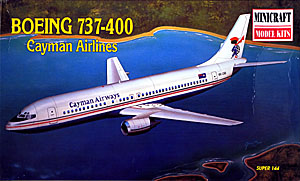Minicraft's 1/144 737-400 "Cayman Airways" | | History Easily the most successful jet airliner of all time, the Boeing 737 family has been in the air since the 1960s and is still going strong. First produced with JT-8 engines, the cost of fuel and new noise pollution regulations pushed Boeing to find a new engine. By mating the CFM-56 engine to the wing, the second generation of 737s was born. There are three main types of second generation 737s, the 737-300, the 737-400 and the 737-500, with the only difference between them being the fuselage length. The 737-400 is the longest of these, with a total fuselage length of 119' 7" and a mixed-class capacity of 147 passengers. The 737-400 first took to the air in 1988 and it has since been a strong asset in many airlines around the world. The Kit 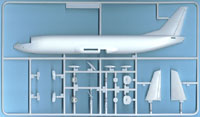 Minicraft's 737-400 kit has been out for a couple years now, but in this release they've changed a couple things. The first, and most obvious, change is the markings. Earlier releases were in US Airways markings, while this one comes in the rather unique and interesting Cayman Airways livery (a peg-leg turtle?). The other change comes when you open up the box and notice that instead of the gray plastic the original was molded in, this kit is now molded in white. As near as I can tell there has been no other changes to the kit, so you're still left with all the problems of the original kit (which I'll get to in due time, don't worry). Minicraft's 737-400 kit has been out for a couple years now, but in this release they've changed a couple things. The first, and most obvious, change is the markings. Earlier releases were in US Airways markings, while this one comes in the rather unique and interesting Cayman Airways livery (a peg-leg turtle?). The other change comes when you open up the box and notice that instead of the gray plastic the original was molded in, this kit is now molded in white. As near as I can tell there has been no other changes to the kit, so you're still left with all the problems of the original kit (which I'll get to in due time, don't worry).
First glance at the plastic shows some very finely recessed panel lines, crisp moldings, and a nice clear sprue. The first thing I noticed on opening this kit is that there are no passenger windows cut out in the fuselage. You're either a fan of this method or not, and since I'm a fan of it, I like it. Minicraft seems to be catering to this group of airliner modelers, as all their airliner kits are this way. The windows are nicely rendered on the decal sheet, complete with the cheatline. The only thing that I'd like to see Minicraft do in the future is to have the window locations scribed into the fuselage sides. This will make lining up the window decals much easier and it will also give a starting point for those who want to cut them out. 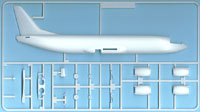 While we're on the subject of the fuselage, though, it is here that the problems of this kit arise. The first problem has to do with the door locations. They are off on this kit, which means that to get some aftermarket decals to fit you'll need to fill them in. The kit decals has the door outlines printed with the cheatline, so they should all line up with the kit. The other problem with this kit is the complete lack of the rear tail bumper. On the longer 737-400 (and 737-800 & 737-900) there is a tail bumper to protect the rear fuselage. The Revell-Germany 737-800 has a nice rendition of this bumper, so if you have one of those kits you can use that as a pattern to add one to this kit. A bit harder to do will be the APU intake on the right rear fuselage side, ahead and below the stabilizer. This also is not present and will be more of a challenge to add. The final missing point on this kit is the lobe crease along the fuselage sides. The 737 fuselage is actually a double-bubble (think Stratocruiser, but not nearly so prominent) which results in a line running at about the cabin floor level ahead of and slightly behind the wing. This isn't difficult to add, though, and can be done in about 10 minutes with some careful scribing and sanding. While we're on the subject of the fuselage, though, it is here that the problems of this kit arise. The first problem has to do with the door locations. They are off on this kit, which means that to get some aftermarket decals to fit you'll need to fill them in. The kit decals has the door outlines printed with the cheatline, so they should all line up with the kit. The other problem with this kit is the complete lack of the rear tail bumper. On the longer 737-400 (and 737-800 & 737-900) there is a tail bumper to protect the rear fuselage. The Revell-Germany 737-800 has a nice rendition of this bumper, so if you have one of those kits you can use that as a pattern to add one to this kit. A bit harder to do will be the APU intake on the right rear fuselage side, ahead and below the stabilizer. This also is not present and will be more of a challenge to add. The final missing point on this kit is the lobe crease along the fuselage sides. The 737 fuselage is actually a double-bubble (think Stratocruiser, but not nearly so prominent) which results in a line running at about the cabin floor level ahead of and slightly behind the wing. This isn't difficult to add, though, and can be done in about 10 minutes with some careful scribing and sanding.
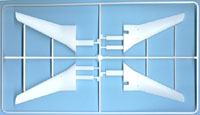 The rest of the kit is the same as that in their 737-300 (which is present in a build-up article in this issue) and has excellent detailing in the engines and wings. The landing gear is petite and well-detailed and should really look good once finished. The engine pods are made up of several pieces and capture that squashed nacelle that's so unique to the 737-3/4/500 family. The rest of the kit is the same as that in their 737-300 (which is present in a build-up article in this issue) and has excellent detailing in the engines and wings. The landing gear is petite and well-detailed and should really look good once finished. The engine pods are made up of several pieces and capture that squashed nacelle that's so unique to the 737-3/4/500 family.
The decals are printed by Scalemaster (Microscale) and are thin, opaque, and in decent register. The only slight alignment problem I could find was with the flag on 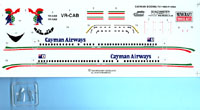 the fuselage, where the red was off by maybe 1/2 of a millimeter, but that has to be one of the toughest things to get printed just right anyway. There is an option for either a decal windscreen or just an outline, so you can have the cockpit windows clear if you so choose. Overwing walkways & engine markings are also included. The peg-leg turtle of Cayman Airways sure does make for an interesting example and the livery will look great on this kit. the fuselage, where the red was off by maybe 1/2 of a millimeter, but that has to be one of the toughest things to get printed just right anyway. There is an option for either a decal windscreen or just an outline, so you can have the cockpit windows clear if you so choose. Overwing walkways & engine markings are also included. The peg-leg turtle of Cayman Airways sure does make for an interesting example and the livery will look great on this kit. Conclusion While the Minicraft 737-400 kit has its faults, there is no beating the price. This kit is very buildable OOB, and the small errors of this kit in no way offset its value. It is still the best injection 737-400 for the price, and with an average of over 800 737s in the air at any given minute, chances are that you'll see one of these planes flying overhead. If all you've built is military aircraft, do yourself a favor and pick up one of these kits. It will be a wonderful diversion from the usual and will add some interesting color to your shelves. | 









    |
